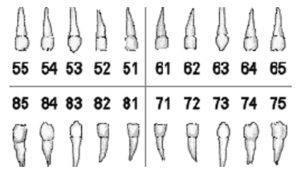

The permanent teeth are described with numbers.

The primary teeth are identified with uppercase letters.In contrast, the teeth are marked using letters or numbers, depending on the dentition: In this system, each quadrant is identified by a special symbol ( ⏌,⎿, ⏋, ⎾ ) instead of a number or letter. It is also known as the Zsigmondy or Palmer-Zsigmondy system. It remains in use today, particularly in the United Kingdom. The Palmer notation system was invented by Dr.Palmer in the late 19th century. 3 - refers to the canine, as it is the third tooth from the midline of the upper jaw.2 - used to describe the left upper quadrant.The sequence number of each permanent tooth within the quadrant is as follows:įDI (ISO-3950) dental notation system for permanent dentition by Anatomy.appįor example, the canine tooth in the upper left quadrant has a numbering of 23:

The quadrants for the permanent dentition are numbered as follows: įDI (ISO-3950) system for permanent dentition

Moreover, each system has different numbers, letters or symbols for each dentition. Regardless of which system mentioned above is used, each assigns a unique number, letter or symbol to each tooth, allowing dentists to precisely identify teeth and plan treatments in a consistent and efficient manner. Dental notation systems for primary dentition by Anatomy.app Dental notation systems for permanent dentition by Anatomy.app The Universal Tooth Numbering System is primarily used in the USA, while dentists in the UK prefer to use the Palmer notation system. Besides the FDI system, two more systems are well-known and widely used, and they include the Universal Tooth Numbering System and Palmer notation system. However, the FDI system, also known as the ISO-3950 system, is the most commonly used dental notation system. Several dental notation systems are used all over the world. These systems accurately describe a particular tooth to ensure consistent and effective communication between dental professionals. These teeth numbering systems are known as dental notation systems, and they are standardized ways of identifying a location of a specific tooth in the oral cavity. Dental practitioners worldwide use various systems to make descriptions and write down information about the teeth of their patients.


 0 kommentar(er)
0 kommentar(er)
